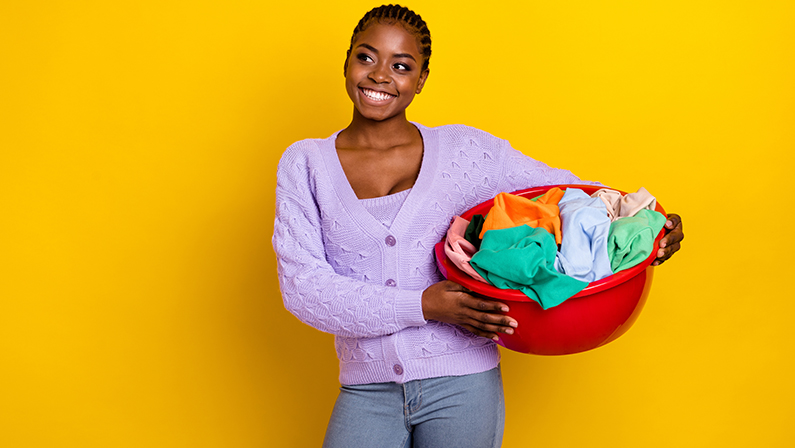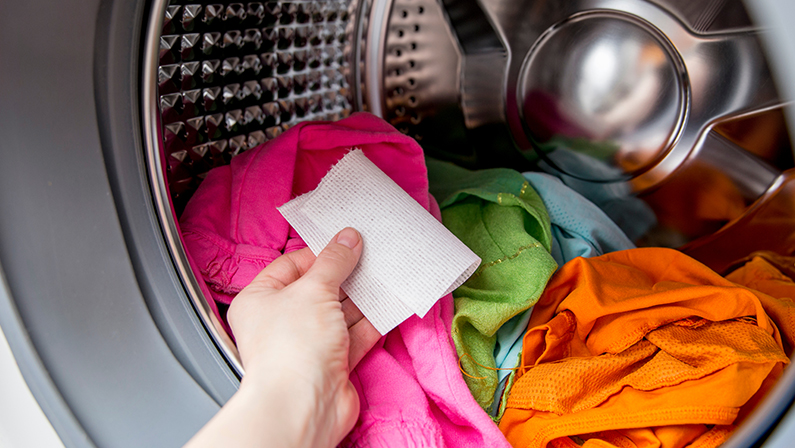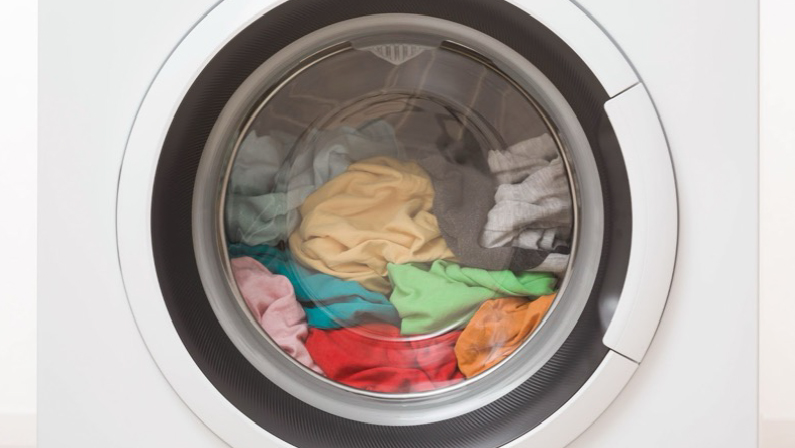Navigating laundry rules can be a daunting task for many. The fear of color bleeding and the tedious task of sorting piles of laundry based on color and type often raises the question: can we dry different colors together?
In this guide, we’ll go into the details of mixing colors in the dryer and provide insights into managing a less stressful laundry day.
Is It Safe to Mix Different Colors in the Dryer?
The answer to this depends on several factors, including the type of fabric, color fastness, temperature setting, and more.
While it’s generally safe to dry different colors together as long as their colors have set and they’ve been washed enough not to bleed, precautions must be taken. Ignoring these factors may leave you with a load of garments dyed in unexpected hues.
What Factors Should You Consider?

Before you mix colors in the dryer or even throw every garment together into the washer, carefully review the following determinants:
Fabric Type
Different fabrics respond differently to heat. Some, like cotton, can stand high heat levels, while synthetics require a gentler setting. To avoid fabric damage, sort items by their material and dry similar ones together.
Color Fastness
Colorfast clothes have undergone treatment to prevent their dyes from bleeding. Non-colorfast items can bleed colors in the dryer, especially if the temperature is high.
Similar Colors
To minimize the risk of color transfer, you might want to segregate your laundry by color groups. Drying similar or complementary colors together reduces the chance of a noticeable color bleed.
Temperature Settings
Heat can cause some clothes to shrink or fade. Be careful when drying garments of various colors together. Use the appropriate temperature settings according to the garment’s care label.
Pre-Treatment
Treat any stained garment before cleaning it with the rest of your laundry. Drying a stained item without treating it first can set the stain permanently.
Empty Pockets
Empty out any items from pockets before the drying process as colorful items such as crayons can melt and tinge your clothes.
Garment Condition
Be mindful of torn, frayed, or distressed items. Loose threads or weakened fabric might snag or tangle with other clothes, potentially damaging them.
Size and Weight
Dry similarly sized and weighted garments together to have even drying. Thicker items or larger ones may take longer to dry and could be left damp if dried with lighter, quicker-drying items.
Regular Maintenance
Regularly clean your dryer’s filter and keep a check on the drum for any residual dye or crayon wax that could stain your next load. Regular maintenance will help your dryer function optimally and reduce the risk of color bleeding.
By keeping these factors in mind, you can make your laundry sessions more efficient and extend the life and freshness of your beloved garments.
How Does Color Fastness Impact Drying?
Color fastness refers to an item’s resistance to color bleeding or transfer when subjected to various conditions like washing, rubbing, and exposure to sunlight. When an article of clothing has high color fastness, it means that its colors won’t easily fade or bleed, especially in the drying process. This characteristic makes it safe to mix such garments with others in the dryer without worrying about colors bleeding onto other pieces. It’s worth noting, however, that repeated washing and drying cycles can eventually break down the color fastness of an item.
What Are the Best Practices for Drying Mixed Colors?

Many are still bugged by questions such as can you dry lights and darks together or what colors can you wash together? When drying a mixed-color load, make sure you follow these tips to prevent unwanted color transfer and maintain your garments’ quality and life:
1. Separate by Color
Group clothes in similar or complementary colors together. This practice will help minimize the risk of bright colors bleeding onto lighter ones.
2. Check for Color Fastness
Before mixing clothes in the dryer, test them for color fastness. You can wet a hidden area, then blot it with a white cloth. If color transfers, it’s safer not to dry these items with others.
3. Turn Inside Out
Turning clothes inside out helps prevent colors from fading and minimizes the friction that can wear out the material.
4. Use a Low Heat Setting
High heat can cause colors to fade and certain fabrics to shrink. To preserve your clothes, choose the cool or warm setting when possible.
5. Use Color-Catching Sheets
Color-catchers trap loose dyes and prevent them from staining other clothes. They can be particularly useful when drying new, brightly colored items.
6. Don’t Overload the Dryer
Overcrowding the dryer can result in uneven drying and increase the potential for color transfer. Check if there’s enough space for clothes to tumble freely.
7. Remove Promptly
Remove clothes promptly to avoid set-in wrinkles. Leaving colorful clothes sitting in a warm dryer can also increase the risk of color transfer.
8. Air Dry Delicate Items
Some clothes, like delicate fabrics and heavily dyed fabrics, are best left to air dry. This method is gentler on the fabric and prevents any chance of color bleeding or fading.
9. Clean the Dryer
Regularly clean your dryer, including the lint trap, drum, and exhaust vent. This helps maintain its efficiency and reduces the chances of residual dyes contaminating future loads.
Addressing Common Concerns and Misconceptions

While dealing with laundry tasks, it’s easy to get entangled in myths and misconceptions. Let’s debunk some common ones:
1. Myth: Mixing colors in the dryer always leads to color bleeding.
Fact: As long as items are colorfast and have been washed enough times to prevent dye bleeding, it’s often safe to dry different colors together.
2. Myth: All fabrics can be dried together without issues.
Fact: Different fabrics have different heat tolerance levels and drying times. It’s best to sort clothes according to fabric type to prevent damaging them.
3. Myth: Drying mixed colors will cause all garments to shrink.
Fact: It’s not the mixed colors that cause shrinkage, but the heat setting used in your dryer. Using the right temperature for different fabrics will prevent shrinkage.
4. Myth: Drying clothes inside out doesn’t make a difference.
Fact: Drying clothes inside out can protect colors from fading and fabrics from pilling.
5. Myth: It’s safe to dry all colors together as long as the temperature is low.
Fact: While lower temperatures can minimize color bleeding, some non-colorfast items can still release dyes when wet. It’s better to test color fastness before drying mixed colors together.
6. Myth: Adding more dryer sheets will prevent color bleeding.
Fact: While dryer sheets can help reduce static and make clothes softer, they do not prevent color transfer.
7. Myth: Overloading the dryer is okay as long as the clothes fit inside.
Fact: Overcrowding can hinder effective tumbling, resulting in unevenly dried items. It can also lead to increased friction, which may cause color transfer among clothes.
8. Myth: Clothes must be dried immediately after washing to prevent color bleeding.
Fact: While leaving wet clothes sitting can cause color bleeding, it’s generally due to the presence of non-colorfast items. Proper sorting before washing and drying will help prevent this.
Is Pre-Treating Necessary for Preventing Color Transfer?
Pre-treating clothing, especially new garments or those with vibrant colors, can be a crucial step in preventing color transfer during the drying process.
This inquiry often relates to the common question: “can you mix white clothes with colored?” Before attempting to mix, pre-treating can help affix the dye within the fabric, thereby reducing the risk when you dry white and colored clothes together.
Applying a stain remover or soaking clothes in a water and detergent mixture can help lock in colors and reduce the likelihood of dyes bleeding onto other fabrics.
How Can You Test for Colorfastness Before Drying?
Testing for colorfastness should be a standard practice before placing items in the dryer, especially when dealing with new clothes or textiles that haven’t been washed before.
This is particularly important if you’re wondering, “can you dry all colors together?” or “what colors go together in laundry?”
To do this, dampen a hidden part of the garment and press it with a white cloth. If dye transfers to the cloth, that item is not colorfast and might bleed in the dryer, complicating the process if you are hoping to mix colors in the dryer.
What Impact Does Drying Method Have on Color Preservation?
The method of drying can significantly affect color preservation. High heat can accelerate color fading, while tumble drying can cause additional friction that might contribute to color loss. This is a key consideration if you’re considering whether “can you mix colors in the dryer.”
Air drying, using a lower heat setting, or employing a dedicated drying rack can help maintain the vibrancy of your clothes.
Are There Specific Garments That Should Always be Dried Separately?
Certain garments, like heavily dyed jeans, bright and dark colors, or delicate items, are more prone to bleeding or becoming damaged and should often be dried separately.
When approaching the task of laundry, many wonder “can black and white clothes be washed together?” The answer depends on the colorfastness of the garments involved.
Heavily stained clothes and garments with embellishments or hardware could also benefit from individual drying to avoid damaging other items in the load.
How to Properly Dry Your Clothes to Avoid Any Damage
Proper drying of clothes is imperative to avoid damage. Always read the care labels and group similar textiles to ensure everything is appropriately sorted. It’s crucial when trying to determine “can you dry white and colored clothes together”?
Remember, overloading the dryer can restrict movement and result in uneven drying, while excessive heat can cause shrinkage or fading.
By following these steps and understanding the properties of your clothing, you can prevent unwanted surprises in your laundry routine.
Whether you’re a patron of a Full Service Washateria in Houston like Clutch City Laundry or tackling laundry at home, these tips will help you maintain the quality and longevity of your wardrobe.
FAQs
Here are some commonly asked questions to help you:
Can you dry whites and darks together?
It is not recommended to dry whites and darks together because dark items may bleed onto the whites, especially if the darks are not colorfast or are new.
Can you wash colors with whites?
Generally, it’s best to avoid washing non-colorfast colors with whites. However, if you are washing colorfast items that have been washed several times before, it should be safe.
What colors can you wash together?
You can usually wash light colors together without issues, such as pastels and whites. Darker colors like reds, blues, and greens can often be washed together once they are known to be colorfast.
Full Service Washateria in Houston: Your Laundry Ally
In Houston, a full service washateria like Clutch City Laundry can take the guesswork out of your laundry routine. We offer a range of services from washing, drying, to folding your clothes, seeing to it that each garment receives the care it needs without risking color transfer or damage.
We understand the hassles of proper textile care, making them invaluable for busy individuals looking to preserve the quality and longevity of their wardrobe.Clutch City Laundry stands out as a dependable option for ensuring your brightly colored clothes remain as vibrant as Houston itself.




